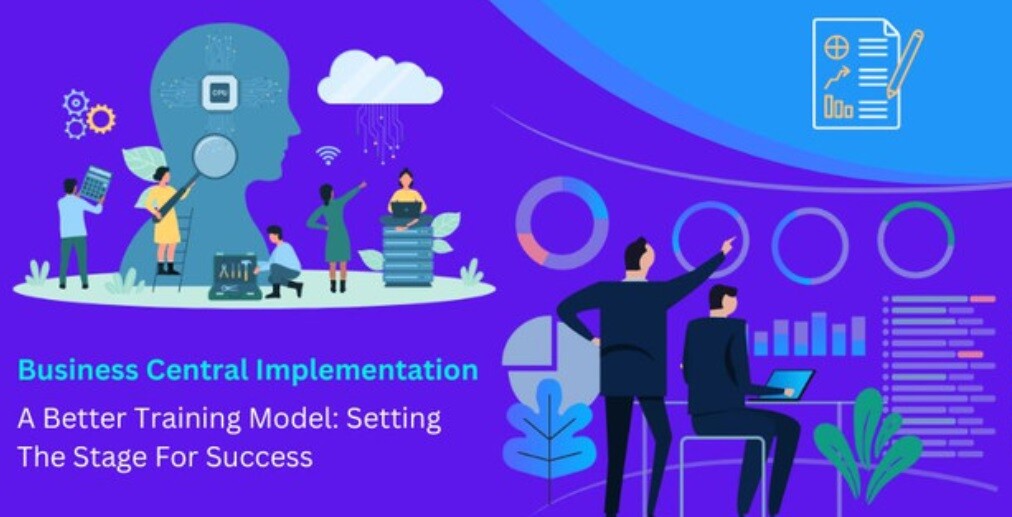Business Central Implementation Training: Why The Traditional Approach Almost Always Backfires
For many companies embarking on the journey of implementing Microsoft Dynamics 365 Business Central, the default training approach often consists of traditional classroom-style lectures and demonstrations. This tried-and-true method is well-established, with users gathering together to receive an overview of the new ERP system’s features through presentations. The goal is to impart essential information in the most efficient manner possible. However, in the context of Business Central implementation, this traditional training approach frequently needs to be revised, often leading to a host of issues that hinder the successful adoption of this critical software.
The Traditional Approach: A Flawed Foundation
Lacking Hands-On Practice:
One of the most glaring drawbacks of the traditional classroom setting is the lack of hands-on practice. Users spend hours sitting, listening, and watching demonstrations, but they seldom get the chance to actively engage with the system. As a result, they leave training without having worked through real-world scenarios or gaining confidence in performing tasks independently within Business Central. This absence of practical experience often translates into anxiety about using the new system after training has concluded.
Information Quickly Forgotten:
Another notable issue is the challenge of retaining information learned through passive lectures alone. When users return to their daily roles after training, they frequently find themselves unable to recall executing even the most basic functions and tasks within the ERP system. Without the reinforcement of hands-on application and practice during training, any information conveyed tends to fade from memory rapidly.
A One-Size-Fits-All Method:
In addition to these shortcomings, the traditional classroom model adopts a one-size-fits-all approach. The training provided is typically generic and covers a broad spectrum of topics and features. However, different job roles within an organization demand distinct sets of skills and knowledge. What is essential for a sales representative might differ significantly from what a production manager requires. By offering generic overviews, this approach leaves users ill-prepared for their specific responsibilities within Business Central.
Lacking Ongoing Support:
Finally, the traditional approach treats training as a one-time event, rather than an ongoing process. The transition to a new ERP system like Business Central is a substantial change, one that necessitates continued guidance, refreshers, and support as users adapt. Unfortunately, the traditional approach is often ill-equipped to provide this necessary ongoing support system.
A Better Training Model: Setting The Stage For Success
The traditional lecture-heavy training model falls short in the context of Business Central implementation. To ensure a more successful transition, organizations need to adopt a new approach that addresses these limitations head-on.
Hands-On Learning And Practice:
In this revamped approach, training takes on an immersive character. It includes dedicated hands-on lab sessions where users actively engage with examples, tasks, and scenarios within the actual Business Central system. This hands-on approach empowers them to practice their skills and grow comfortable with the software before they need to use it independently.
Customized For Each User:
A significant departure from the one-size-fits-all approach, this model tailors the curriculum to the specific job functions of each user. Instead of generic overviews, training focuses on targeted, role-based learning paths. This ensures that users acquire the most relevant skills for their day-to-day responsibilities.
Ongoing Support Post-Training:
Acknowledging that training doesn’t end when the classroom session concludes, this approach provides ongoing support. This can take the form of refresher sessions, quick guides, help desks, and opportunities for collaboration. Comprehensive assistance continues as users adapt to using Business Central in their daily work.
Measuring Success:
To measure the success of Business Central implementation, organizations can track user adoption rates, assess user confidence in utilizing the system, and gather feedback to continually refine the training approach.
Case Studies: Real-World Success Stories
Real-world case studies can exemplify how the new training approach has yielded positive results. Organizations that have embraced hands-on, customized, and ongoing training methods tend to experience higher user satisfaction, faster adoption, and a more efficient transition to Business Central.
The Role Of Training In ROI:
Investing in proper training is not just an expense but an essential part of realizing a return on investment. Effective training ensures that the ERP system is used to its fullest potential, which, in turn, leads to greater efficiency, improved decision-making, and ultimately, higher profits.
Integration With Business Goals:
A well-crafted training approach should align with an organization’s broader business goals. By customizing training to the unique needs of various departments and job roles, companies can ensure that Business Central becomes a valuable tool that enhances the overall business strategy.
The Challenge Of User Resistance:
User resistance to change is a common hurdle in any implementation. Traditional training methods often exacerbate this resistance due to the disconnect between the training room and the work environment. Hands-on training and ongoing support can help reduce this resistance, as users become more confident in their abilities.
Scalability And Adaptability:
The new training approach isn’t just about onboarding current employees. It also offers the flexibility to scale and adapt training methods to accommodate new hires and evolving business needs. This scalability is crucial for organizations looking to expand or diversify their operations.
The Role Of Technology:
Utilizing e-learning platforms, virtual classrooms, and interactive simulations can enhance the training experience and make it more engaging and accessible for users.
A Cultural Shift:
Implementing this new approach is not just a shift in training methods; it represents a cultural change within the organization. It emphasizes the importance of continuous learning, adaptability, and a commitment to harnessing the full potential of Business Central.
Conclusion:
By embracing a hands-on, customized, and ongoing training approach, businesses can ensure the success of their Business Central implementations. This stands in stark contrast to the traditional lecture-heavy model that often backfires, leading to low user adoption and, ultimately, hampering the benefits of the new ERP system. It’s high time for companies embarking on the Business Central journey to rethink how they train their users for long-term success, ensuring that this essential tool is leveraged to its full potential.
You may also want to read,










